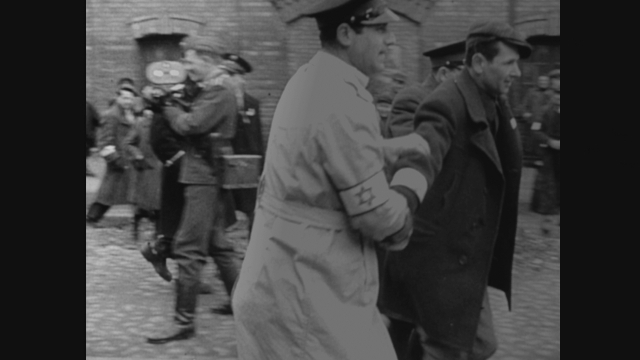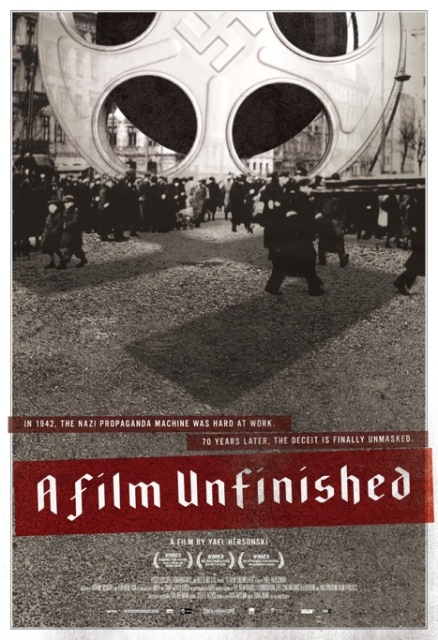CHICAGO – In the last several years, how many times have you wanted to shout the “Mad as Hell” movie quote? Well, Invictus Theatre Co. has produced a stage adaptation of “Network” – with that quote shout worthy – at the Windy City Playhouse in Chicago through September 29th. For tickets/details, click HOWARD BEALE.
‘A Film Unfinished’ Explores the Complexity of Imagery
 Rating: 4.5/5.0 |
CHICAGO – The power of a single image is often far greater than any amount of written words. In a culture as visually over-saturated as our own, it’s so easy to take images for granted. Our days are too hectic, and our minds are too cluttered to view every piece of footage filtered down to us from the mainstream media with the same critical eye and healthy dose of skepticism.
Similarly, many moviegoers don’t have the luxury to discern between a good film and a mediocre one when catching a movie on a Saturday night. That’s why it’s the job of critics to look behind the moving image and investigate its complexities, its meaning, its relevance and its inherent worth. “A Film Unfinished” is, among other things, an accomplished and essential work of critical analysis, deconstructing one of the most notorious and misinterpreted pieces of archival footage ever unearthed. It carries the remnants of an aborted film project that was destined to be the largest Nazi propaganda picture ever made.
For her feature film debut, writer/director Yael Hersonski set her sights on exploring the 62 minutes of raw silent footage that was shot inside the Warsaw Ghetto in May of 1942. It was meant to be part of an uncompleted film titled, “The Ghetto,” though almost no information about its makers has ever been found. What has been discovered are multiple diary entries from people who were present during the filming, and Hersonski expertly juxtaposes their revealing words with the appalling imagery, providing an insightful running commentary for the mystifying events flickering on the screen. We hear from the ghetto commissioner, Heinz Auerswald, whose neatly typed formal reports are chilling portraits of the passivity of evil. He laments about the “lack of cooperation” among prisoners to participate in a film project aiming to not only misrepresent their suffering, but also to justify their own extinction.

Filmmaker Yael Hersonski deconstructs fragments of what would have been the largest Nazi propaganda picture ever made in A Film Unfinished.
Photo credit: Oscilloscope Laboratories
“A Film Unfinished” contains nearly all of the found footage from “The Ghetto,” with pauses between reel changes. Though this documentary may seem like something that easily could’ve gone straight to HBO, the experience of viewing these images on a large screen is crucial, not just because that’s the way they were originally intended to be viewed, but also because it enables viewers to scrutinize the corners of the frame, and the multi-layered lies being staged as truths. Occasionally, Hersonski slows down the footage, allowing the faces of the ghetto inhabitants to pause before us, their eyes averted toward the lens. They convey an emotional turbulence and honesty that transcends the artifice of the surrounding frame, and penetrates directly into the soul of the moviegoer. Some of the faces are contorted in fear, as their captors resort to discharging firearms in order to acquire a desired reaction on film. Others appear somewhat hopeful, partly because they believed that their participation in the film was their ticket out of the ghetto, when in fact the “cast members” were promptly shipped to liquidation camps after production wrapped.
One of the most haunting perspectives articulated in the film is that of Jewish Council leader Adam Czerniakow, whose diary included candid descriptions of the film’s production. He discusses how various scenes were staged to make some ghetto inhabitants look as if they’re living in the lap of luxury, while their wealth is sharply juxtaposed with the extreme poverty of others. Most detestable of all are scenes where the “rich” characters are seen ignoring the poor beggars, as if to convey the notion that Jews are inherently selfish. These particular sequences are scoffed at by five Holocaust survivors, whom Hersonski invited to view the footage and provide their insights and memories. As a smiling, elite housewife places a vase of flowers on her table, one of the survivors replies, “We never had flowers. We would’ve eaten a flower.”

Yael Hersonski’s A Film Unfinished opened at the Landmark’s Renaissance Place Cinema on Oct. 1, 2010.
Photo credit: Oscilloscope Laboratories
Perhaps most tantalizing of all are the outtakes contained on a separate reel that weren’t discovered until 1998. They include alternate takes of various sequences, including some footage shot in startling color, that bring even more unsettling immediacy to the historic tragedy. There’s one particularly disturbing scene where “actors” were ordered to cram into a theater to watch Yiddish performers, who were instructed by their German directors to overact. The audience was ordered to explode with laughter and applause on cue for the entire day, without ever being allowed to leave the room.
Another scene stages an extravagant burial for a deceased member of the ghetto, proving that some Jews die with dignity. This is later followed by a sequence that may be familiar to Holocaust historians, yet is equally horrifying every time it is observed: a tangled mass of the dead thrust into a gruesome landfill, the Nazi’s ideal farewell to their victims. Several of the survivors understandably shield their eyes during this scene. One woman reflects on how the ghetto forced its inhabitants to drain themselves of their humanity if only to preserve their sanity and ensure their survival. But now, faced with this footage, tears begin to form in the woman’s eyes, no longer immune to the pain. “I’m now human,” she says, “Now I can cry.”
Though practically everything in “A Film Unfinished” is true, it does have its own fair amount of staging. Of course, none of it is concealed. Various scenes utilize two actors and a 1960 court transcript to recreate the interaction between an interrogator (Alexander Beyer) and cameraman Willy Wist (Rüdiger Vogler), the sole person unmasked as being a part of the “Ghetto” filmmaking crew. Bearing a striking resemblance to Robert McNamara in “The Fog of War,” Vogler recites the words of a man clearly haunted by the atrocities that he recored, yet unwilling to admit that he understood their meaning or significance. If Wist was telling the truth, then the filmmakers were as much a pawn in the Nazi’s games as the prisoners themselves. There are still many questions left unresolved by “A Film Unfinished,” which is as it should be. Critical thinking has rarely appeared more vital than it does than at the end of this shattering, provocative, remarkable film.
 | By MATT FAGERHOLM |


